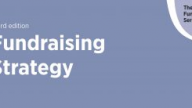The second step in building your fundraising strategy
Richard Sved shares his top tips for creating a robust fundraising strategy.
“Where do we go from here?” Bobby Womack
This is the second of three short blogs based on, but by no means doing justice to, the 200 page book on Fundraising Strategy for DSC, which I co-wrote with Dr Claire Routley. In a recent blog, I looked at how we can understand where we are now (if you haven’t read that yet, do check it out and then come back to read this one – I’ll still be here). In musical lyrics terms, we’ve moved on from David Bowie to Bobby Womack: this second blog is about where you want to get to with your fundraising strategy.
Because having focused on understanding the state of play internally and externally for your organisation’s fundraising, you’re hopefully now armed with the insight and information you need to think about your fundraising objectives and audiences.
How do you set carefully thought through overall objectives for your fundraising? I would recommend going back to the SWOT analysis you did earlier (having been inspired by the first blog!) and consider these questions:
- How can we use the strengths we identified to take advantage of our opportunities and avoid threats?
- How can we minimise weaknesses so that might prevent us doing so?
- How might ensuing objectives inter-relate, or are any of them overarching objectives?
- In what order of priority would we put them?
It has become a bit of a planning cliché, but still needs to be said: it’s important to make sure that our objectives are SMART – Specific, Measurable, Achievable, Relevant and Time-bound. In addition, our fundraising objectives should of course set out
- the amount of income that will be raised
- the types of donor that will supply these funds
- the acceptable cost of raising the funds
Having outlined our objectives (we can continue to refine them), we now need to think about the audience or audiences for our fundraising, and what messages we can develop for them. Essentially, we need to think about which groups of donors we’re appealing to, and how to make a case as to why they should support our charity.
To think about growing fundraising, I’d always recommend a version of Ansoff’s Matrix (we go into much more detail in the book) through which it’s possible to think about how to develop your existing successful products to new audiences, or bring new products to existing audiences.
We should also think carefully about segmentation and targeting – because “spray and pray” never works! There is a range of possible criteria, but those that might be applied to individuals include demographic (age, family status, income, education and so on) and geographic (the country, town or region where supporters are based). There’s also geo-demographic and psychographic but we don’t have time to go into that right now!
Arguably, the first segmenting criteria however is how close they are to our organisation already. It goes without saying that a “warm” supporter is likely to respond differently to a “cold” potential supporter. For warmer supporters, think about segmenting through, for example, how they donate, how often, how much they give, and how recently they gave. For colder supporters, meanwhile, think about demographics, lifestyle, and affinity to the cause, for example.
And having identified your supporters and potential supporters, what aspects of your organisation’s work will you want to communicate to them? How can you make your message simple and uncluttered? What about your brand – is there a way you can build a shorthand in the mind of the supporter of what your organisation can offer?
And no fundraising strategy is worth even worth the paper it’s printed on without detailed consideration of the case for support. Why us? Why now? Why should a donor care?
This analysis should help you to identify your objectives, your targets, your priority segments and your messaging.
You’re now across where you are now as a fundraising organisation, and where you want to get to, and have begun to think about how you will get there (the devilish detail of tactics, which will be the subject of the third blog).
Buckle up and get ready for the ride!


